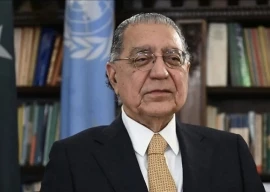
KARACHI:
At the Victoria and Albert Museum’s Victoria Memorial Hall in Kolkata, India, the Dancing Girl stands quietly far away from home. Famous the world over, people love to have her in their drawing rooms, but the most recognised symbol of a once-mighty civilisation apparently has no admirers back home.
Perhaps this is the reason why the government has made no efforts to bring back the original bronze figurine of the Indus Valley Civilisation’s Dancing Girl taken away from its homeland in the 1930s.
Although former prime minister Zulfikar Ali Bhutto had succeeded in getting the King Priest statue back from India under the Simla Agreement in 1972, no government since then has taken any interest in this regard. Archaeologists contend that under the Unesco Convention of 1972, the original owner of any artefact is the country where the relic was found.
Though the people and the government officials believe the “real” priest is on display at National Museum, Karachi, the officials there say it is not the original relic. “Since it is a rare object, we have placed it in reserve and display replicas at the museum and at Mohenjodaro too,” said Qasim Ali Qasim, the Sindh Archaeology Department’s director.
He told The Express Tribune that many rare artefacts of the ancient Egyptian civilisation were also taken away, but the government started correspondence with other countries and even registered cases against the accused states and took back their archaeological treasures. “We took back around 13 sculptures of the Gandhara civilisation from other countries in 2009 and will recommend to the federal government to pursue the case of Dancing Girl too,” he added. The dancing girl’s statuette stands around 10.8 centimetres high. According to archaeologists, the black figurine with a “cheeky” look depicts a nude girl not more than 15 years old. She is wearing bangles like the Thari women with one hand on her hip in a half-impudent posture.
As Gregory Possehl, professor emeritus of anthropology at University of Pennsylvania, in his book had stated: “We may not be certain that she was a dancer, but she was good at what she did and she knew it.”
The statues of Dancing Girl and King Priest are some of the most renowned artefacts of Mohenjodaro – an archaeological site of one of the world’s oldest civilisations – in Larkana, Sindh.
The figurine of King Priest is made of steatite (soapstone) and the Dancing Girl is of metal. Archaeological experts have dubbed the masculine statue as the “King of Mohenjodaro”, as it depicts a bearded man supposedly wearing an ajrak with his hair combed back.
Excavation first began at Mohenjodaro in 1922, after Indian historian and archaeological expert Rakhaldas Bandyopadhyay noticed some signs of an ancient civilisation on a visit to the site in search of Buddhist relics. In 1930, proper excavation was started by John Marshall, the Archaeological Survey of India’s director general.
Ali Hyder Gadhi, who works as an archaeological conservator of Mohenjodaro, says both the statues were initially taken away in the 1930s by John Marshall and put on display at Delhi Museum.
“When [Zulfikar Ali] Bhutto tried to get back the relics, then Indian prime minister Indira Gandhi refused and told him to choose one of them,” Gadhi told The Express Tribune. “Bhutto preferred the statue of King Priest over the nude dancer.”
Soon after getting the statue back, the Pakistani government started the “Save Mohenjodaro” campaign and also participated in an archaeological exhibition held in Japan in 1974. “During the exhibition, the government was offered $10 million for King Priest, but it refused,” Gadhi said.
The curator believed that not only the dancing girl, but many other artefacts of the Indus Valley Civilisation recovered from Mohenjodaro had been taken away by excavators or archaeologists.
He spoke of one of the best-known British archaeologists of the twentieth century, Mortimer Wheeler. “[Wheeler] had given a rare necklace found from Mohenjodaro as a gift to his wife,” said Gadhi.
The British archaeologist had described the Dancing Girl as “his favourite statuette ever found from an archaeological site”. More unique sculptures can be found from Mohenjodaro, which has been excavated around 10 per cent hardly, he added.
Following the 18th Constitutional Amendment, the archaeology ministry was devolved to the provinces, but the government has not taken any initiatives to bring back the Dancing Girl artefact. The archaeology department now falls under the provincial culture ministry.
Talking to The Express Tribune, Sindh Culture Minister Sassui Palijo said that the department is in a transition phase after devolution, but will write to the federal government to bring back the statue from India.
Published in The Express Tribune, July 17th, 2012.
COMMENTS (3)
Comments are moderated and generally will be posted if they are on-topic and not abusive.
For more information, please see our Comments FAQ























1713272658-0/Copenhagen-fire-(1)1713272658-0-270x192.webp)















Umm, pakistan didnt exist in 1930, it was all India ergo the Priest King and Dancing Girl were found in India meaning they belong to India. India was the successor to the Indus Civilization and pakistan was the successor to the crapshoot called Mughal/Persian India. Get over yourselves, never before in history was there anything significant to civilization and cultural development called pakistan. deal with it.
good piece indeed.
I am working on a documentary on the Harappan/Sindhu river civilization called In search of Meluhha: The story of Mohenjodaro. The movie was shot last Nov in Mohenjodaro and Karachi and explores the history and the current impact of the civilization on modern Pakistan.
More here at insearchofmeluhha.com